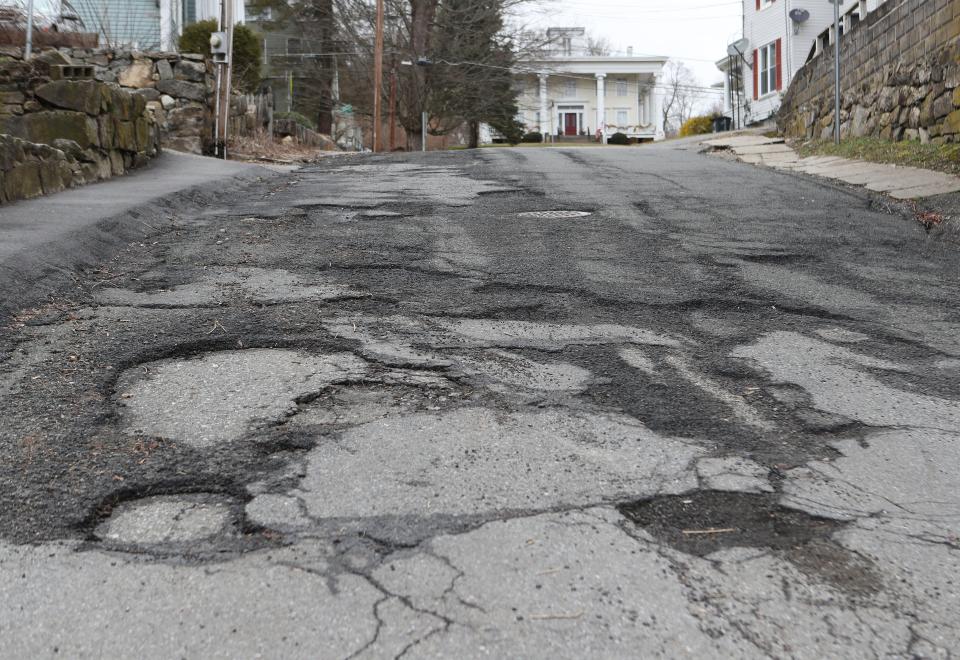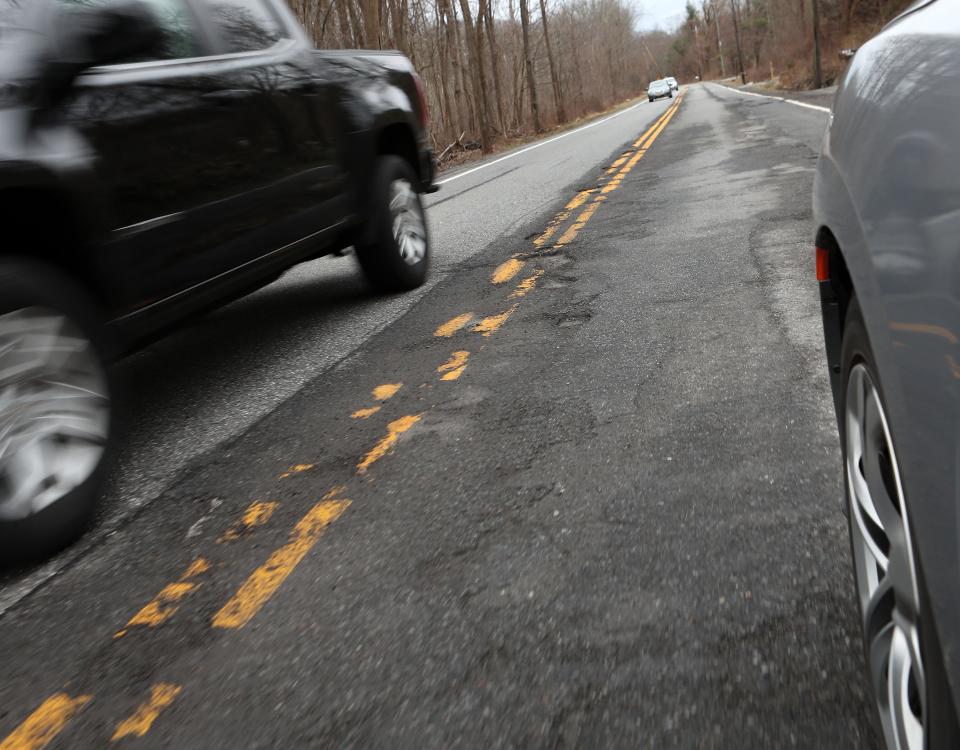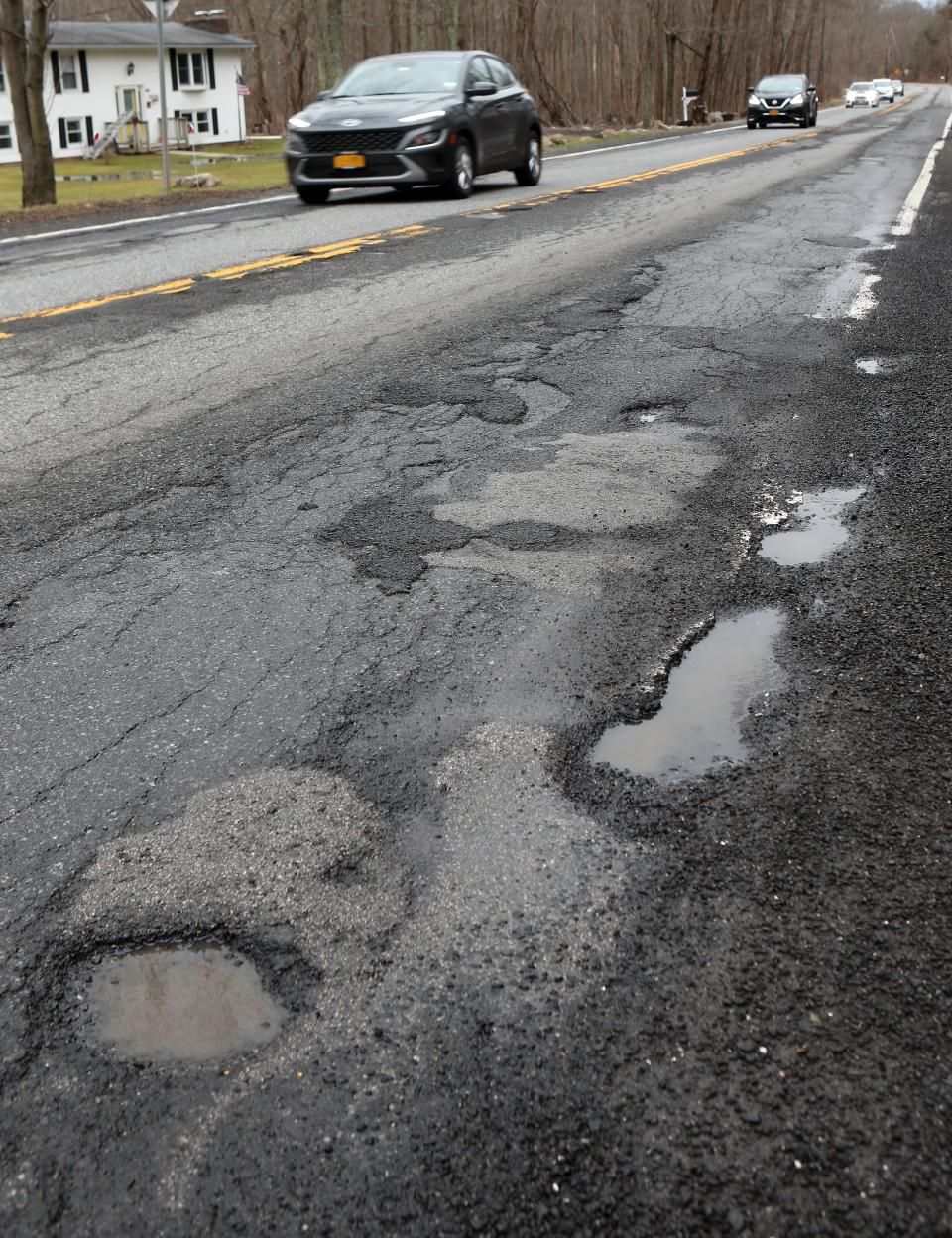Potholes: Where are they worst in Lower Hudson Valley and what's being done?
As spring approaches, flowers aren't the only thing that's blooming. Potholes resembling moon craters are popping up all over the Lower Hudson Valley after a winter full of snow and heavy rain.
Readers chimed in about the issues on local roads and many agreed that Route 9A, a 47.25 mile state highway that runs from Route 9 in Peekskill to the FDR Drive in Manhattan, has the worst stretch of potholes in the Lower Hudson Valley.
Eliza McCarthy lives in Croton-on-Hudson. She said she has noticed more and more potholes on almost every stretch of road on Route 9A and on Route 129 in her town in recent years.
“To me, it seems like with so many cars getting bigger and heavier and a lot of our roads in Westchester are pretty old, they’re pretty narrow to begin with," McCarthy said. "So to have them in good shape just seems really important for safety.”
Specifically, readers said the area from Route 9 in Ossining to the entrances of the Taconic State Parkway and the Saw Mill River Parkway in Mount Pleasant are the worst stretches of the route.

Other problem areas in the Westchester County area include Route 35 in Cross River, Routes 100 and 118 near Somers, and the Sprain Brook Parkway in Hawthorne and Valhalla.
Keri Reitman Schnapper, who lives in Somers, said her family avoids certain roads altogether, including 9A and 118 in Somers.
“We avoid certain roads because it is so dangerous and we don’t want to be involved in any sort of accident or damage our vehicle," Reitman Schnapper said. "We notice that potholes are filled with blacktop often, but those are near-term fixes for longstanding issues.
How to solve the pothole problem in government
In Rockland, the road with the most issues is Route 59. Readers said road conditions are worst in Monsey and in West Nyack, particularly in front of the Palisades Center mall.
Route 59 is notorious in the Rockland community for flooding during significant rain storms. Just last year, Clarkstown Supervisor George Hoehmann called on the state to address the flooding issue on that stretch of road after it flooded on Jan. 12 for the eighth time in a little more than a year.
“This is a significant problem. We've reached out to New York state several times. We’ve been in conversations with the DOT, we’re working with our local assemblyman and senator to try and get New York State to take this seriously," Hoehmann said. "It’s unacceptable that a major state roadway, which is a major artery through our town, closes this many times due to flooding."
However, different departments are responsible for different roads in the state. New York State Department of Transportation handles funding and repair for state roads and the Thruway, county roads are handled by each respective county's Highway Department and town roads are handled by town highway supervisors, according to Clarkstown Highway Superintendent Bob Milone.
The Department of Transportation said in response that it regularly monitors the area to make changes and sends emergency crews to clean up the flooding when it does occur but said the solution doesn't lie with the state department.
"Safety is always the top priority of the New York State Department of Transportation and we take the threat of flooding along any of our roads very seriously," spokesperson Heather Pillsworth said, "However, a solution to this problem will require action that goes beyond NYSDOT’s jurisdiction over the state highway system."
Other roads with poor quality, according to readers, include Route 9W from Haverstraw to Bear Mountain State Park in Stony Point, Spookrock Road in Montebello and Union Road in Spring Valley.
"Some of these potholes are about 3 feet wide and nearly 10 inches deep," New City resident Nick Rooney said. "It's like these roads have built-in speed bumps."
What happens if you hit a pothole?
TRIP, a transportation research group, said New York's road conditions cost local drivers $8.7 billion total, or $715 per driver, in repairs in 2023.
However, the state Department of Transportation said it's required by state law to reimburse drivers for vehicle damages caused by road conditions up to $5,000.
According to the department's website, "it must be clearly demonstrated that the State although aware of a dangerous condition on the highway, did nothing to remove the hazard, subsequently resulting in damages to a user of the highway."
Anyone can fill out a Small Claims form, found on the DOT website. For claims over $5,000, drivers must file a claim through an attorney with the Court of Claims within 90 days of the damage.
Stakeholders seek more and better funding
Roadworkers who are part of the Construction Industry Council held a rally on Feb. 21 calling on the DOT and lawmakers to increase funding for local road repairs and to support construction and road union members.
John Cooney Jr., executive director of the Construction Industry Council of Westchester and the Hudson Valley, said that the NYS Department of Transportation's Region 8, which encompasses the Hudson Valley, is the region with the worst road conditions in the whole state.
"Across the state, conditions have declined and that is due to a lack of funding. The Hudson Valley has more road miles and more bridges than any other region in New York State, but our region receives the third amount of funding," Cooney said. "The formula for how funding is distributed needs to be looked at again. Overall, conditions are declining but they're declining more steeply in Region 8."

But why are the road conditions so bad? state Sen. Pete Harckham said it came down to two major factors.
"One, it's the freeze and thaw cycles that we're getting more and more of due to climate change, but it's also the amount of traffic that these roads get," Harckham said. "These are incredibly heavily trafficked roads. On my side of the county, we get tens of thousands of cars a day coming from Connecticut to bypass the gridlock on I-684, coming on to our local and state roads."
Cooney said advocates for road repairs like Harckham are still pushing the Department of Transportation for an increase of $400 million in this year's budget for New York State DOT core roads and bridges along with a $250 million increase to aids in local towns, villages and counties to maintain their roads as part of the Consolidated Local Street and Highway Improvement Act, also known as CHIPS.
"The basic thing that government provides are services like roads and we've got to be able to do that for our constituents," Harckham said. "It impacts everybody. It impacts the cost of ownership of vehicles, it impacts quality of life, it impacts economic development. So this is something that we're fighting for in a bipartisan way."
However, Harckham said Hochul recently proposed cuts to the CHIPS act, which has come to be the primary source of funding for hyperlocal road repairs, despite pledging $1 billion to the cause in 2022.
"We do not receive our fair share in Region 8 to maintain our roads and so that's part of the problem," Harckham said. "When the governor proposed those cuts to CHIPS funding, which is the local funding, that's not acceptable. We're not investing enough in the DOT capital plan to repair our state roads."

"Since she started her five year plan, the cost of doing this has gone up 20%," Cooney said, citing Federal Highway Administration statistics. "So that is why we're asking for the increase we're asking for. We need to keep up with inflation at a minimum, but on top of that, the Hudson Valley region needs a bigger share of the overall pie because we have the worst roads and bridges in the state."
Local lawmakers are doing what they can with the resources they have to address the daily bumpy rides through the Hudson Valley. Harckham said the state was able to receive $3 million each for a study of repairs to the Route 9A corridor, the Route 35 and Route 202 corridors.
Cooney said union members also have a yet another reason aside from uncomfortable commutes that bring them to advocate for road repairs: major job opportunities.
"Union members have a workforce that is available to go to work and repair these roads. If the funding increases, there are people waiting to go to work in the Hudson Valley to fix these roads."
The deadline for the New York State budget is April 1.
This article originally appeared on Rockland/Westchester Journal News: Where are the worst potholes in the Lower Hudson Valley?

